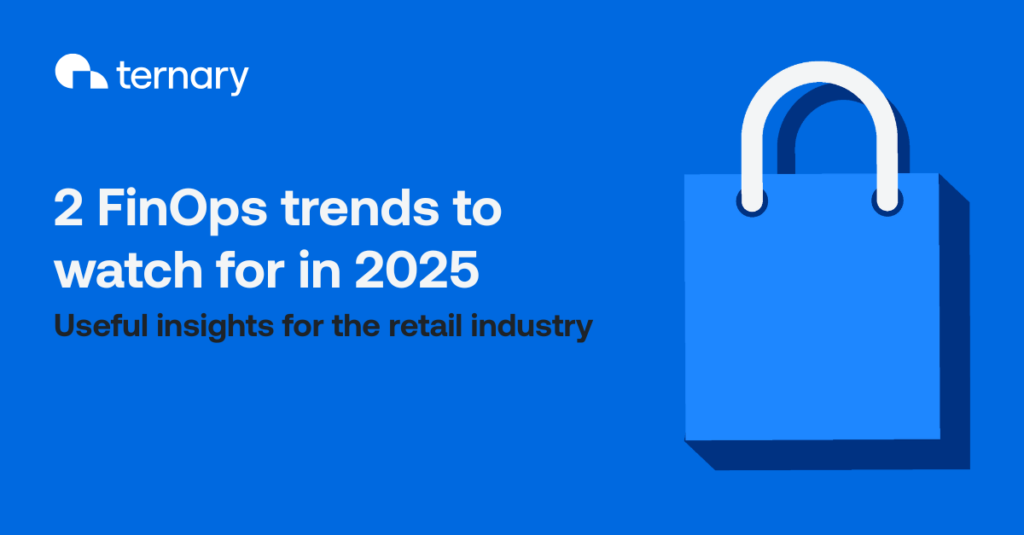The retail and consumer goods industry is changing fast. Consumer demands and new technology are driving a shift where being agile and efficient is key to success. FinOps leads face increased pressure to do more than just monitor cloud spend—they must actively optimize resources to ensure every dollar invested supports business growth. To stay competitive and achieve predictable growth in 2025, it’s important to understand emerging cloud cost management trends. The ability to forecast, adapt, and implement new cost management practices will set FinOps leads apart. This blog highlights two important FinOps trends for retail companies and offers practical insights to navigate cloud cost management.
Trend 1: Strategic implementation of serverless computing
Serverless computing allows you to run applications without managing infrastructure, meaning you don’t have to worry about provisioning or maintaining servers. Instead, you deploy your code, and the cloud provider automatically handles the underlying infrastructure. Cloud providers like Amazon Web Services (AWS), Microsoft Azure, and Google Cloud (GCP) handle server setup, scaling, and maintenance, which can lead to significant cost savings and better scalability. With serverless computing, you pay only for the compute time used, and the system automatically scales based on demand.
For FinOps leads, this means:
- Reduced infrastructure costs: Pay only for the resources your applications consume, eliminating over-provisioning for peak loads.
- Improved scalability: Handle fluctuating demand during sales or seasonal spikes, without manual intervention.
- Enhanced operational efficiency: Free your team to focus on strategy, not routine infrastructure management.
To implement serverless computing:
- Identify applications for serverless deployment. Begin by assessing your existing applications to pinpoint those that can benefit most from a serverless architecture. Look for applications with event-driven workflows or variable workloads, or those requiring rapid scalability. Focus on areas like API gateways, data processing pipelines, and microservices.
- Collaborate with cloud architects and engineering teams for seamless implementation. Engage in detailed planning sessions to design and deploy serverless functions. Ensure your architectural design accounts for factors like function triggers, data storage, and integration with other cloud services. Establish clear communication channels and provide comprehensive training to your engineering teams to facilitate a smooth transition.
- Leverage a FinOps platform or cloud cost management platform for continuous monitoring and optimization. Implement a unified platform that provides granular visibility into serverless function usage and associated costs. Utilize features like cost allocation tagging, performance monitoring, and anomaly detection. Regularly analyze cost data to identify opportunities for optimization, such as adjusting function memory allocation or optimizing event triggers.
Trend 2: The use of predictive cost analytics
Predictive cost analytics uses historical data, machine learning algorithms, and statistical modeling to forecast future cloud spend and pinpoint possible cost inefficiencies. This modern approach to analytics allows FinOps teams to go from reactive to proactive, helping them mitigate potential cost overruns. By adopting predictive analytics, organizations can achieve meaningful reductions in cloud spend and improve budget forecasting accuracy.
For FinOps leads, this means:
- Improved resource allocation. Accurately predict resource needs and allocate budgets accordingly.
- Enhanced budget forecasting. Create more accurate and reliable budget forecasts, reducing the risk of unexpected expenses.
- Proactive cost optimization. Find and address cost inefficiencies before they impact your bottom line.
To implement predictive cost analytics:
- Use a comprehensive FinOps platform or cloud cost management platform with predictive capabilities. Select a platform that offers advanced analytics, machine learning, and historical data analysis. Ensure that it provides features like cost forecasting, human-tunable anomaly detection, and scenario modeling. The platform should integrate seamlessly with existing cloud infrastructure to gather accurate and real-time data.
- Establish data collection and analysis processes to guarantee prediction accuracy. Develop a systematic approach to collecting and processing cloud cost data, then leverage machine learning to identify patterns and trends in your data. You should also define key metrics, implement data quality checks, and set up automated data pipelines. Ensure that your analysis processes are adaptable and can handle the complexities of multi-cloud environments.
- Implement a process to review and refine predictive models to accommodate business requirements. Establish a feedback loop to monitor the performance of your predictive models and identify improvement areas. Adjust model parameters, update training data, and incorporate new variables as needed. Conduct regular reviews with FinOps stakeholders to ensure that the predictive models align with business objectives, reflect current cloud usage patterns, and remain accurate and relevant over time.
Key takeaways for successful cloud cost management
In 2025, serverless computing and predictive cost analytics will be key FinOps trends for success in retail and consumer goods. Adopting these trends will optimize cloud investments, improve operations, and drive business growth. Predicting cost changes and automating infrastructure monitoring will be competitive advantages, and those who adopt FinOps best practices will cut costs and find new ways to innovate.
To practice effective change management, it’s imperative to understand these trends and use appropriate tools. Ternary’s unified FinOps platform empowers teams with comprehensive visibility into cloud spending, offering actionable insights across multi-cloud environments. Retail and consumer goods companies using FinOps platforms like Ternary can achieve up to 30% savings in cloud spend through efficient cost management and optimization.
Ternary helps businesses identify cost optimization opportunities and proactively manage cloud resources. The platform’s ability to provide cost analysis, budget forecasting, and anomaly detection transforms cloud spend into a strategic asset, enabling data-driven decision-making and fostering financial accountability.
Don’t let cloud cost management complexities slow your business down. See how the Ternary platform can revolutionize your FinOps strategy.
